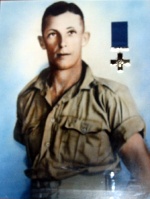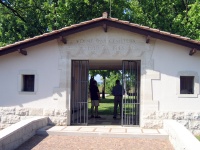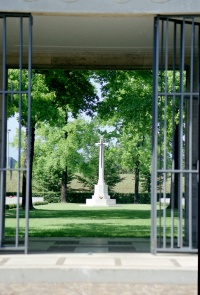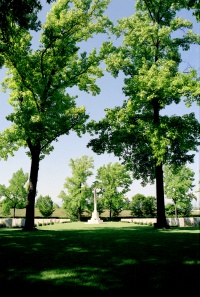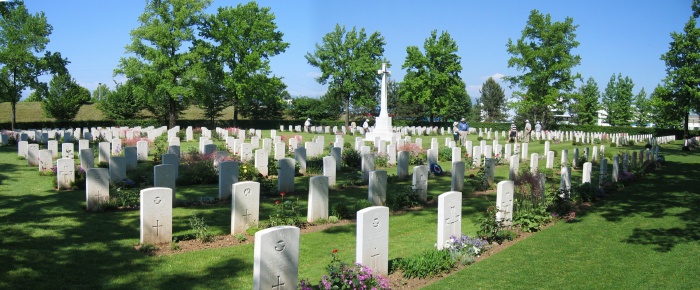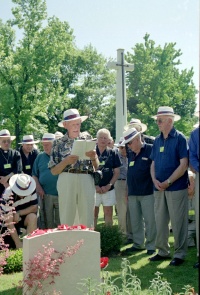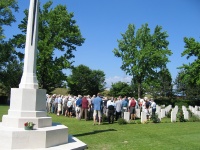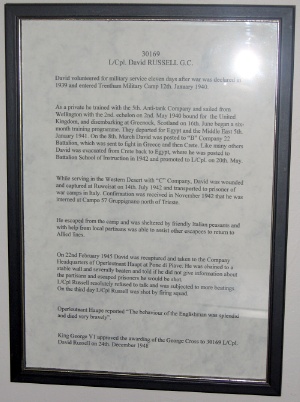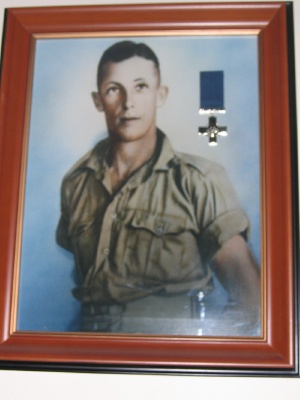David Russell GC
David Russell was born in Ayrshire, Scotland in 1911. Some years before the war he emigrated, first to Australia where he roamed the Outback, before moving on to New Zealand. In 1938 he took up employment with the Hawkes Bay Hospital at Napier as a Orderly. He became engaged to a Napier girl Nancy Oliver (later to be Nancy Wilson). A ward in the Napier Hospital was later to be named after him and a plaque describing his gallantry was erected at the entrance of what became “The David Russell Ward”. In 2005 following the closure of the Napier Hospital this plaque was re-dedicated with due ceremony in the Hospital Chapel at Hastings. When war broke out in 1939 David Russell was amongst the first to volunteer. He sailed with the Second Echelon, first to Britain and then to Egypt. In Egypt he was posted to the 22nd Battalion NZ Infantry Battalion and was action in Greece and Crete. In 1942 in the Western Desert he was wounded and taken prisoner of war at Ruweisat and transferred to a prison camp in Gruppignano north of Trieste, Italy. David Russell escaped during 1943 and joined up with Italian partisans in the area. He arranged for several escaped prisoners to be put in touch with an escape line to Yugoslavia. He was recaptured and returned to a prison camp, this time at Traviscosa near Udine from where he again escaped. He was pursued south to the region of Ponté di Piavé. Here he was hidden by Italian families. In this district he took up, yet again, assisting escaped prisoners-of-war and would visit them by bicycle. He was recaptured in February 1945 by a combined German-Italian Fascist patrol and handed over to the German Commander of the district. He was subjected to intense interrogation and beatings but resolutely refused to disclose any information about fellow escaped POWs or the Italian families who had been sheltering them. He was given three days to give the Germans the information they demanded or he would be shot. Chained to a wall in a stable he was again beaten and this time by an Italian Fascist who “used special methods”. Even this treatment did not break his resolve and after 3 days he was taken from the stable and forced to stand before a concrete wall. Here David Russell was asked if he had anything to say but replied that he did not. He asked for a cigarette and smoked part of it. Throwing the cigarette aside, he stood to rigid attention facing the firing squad and died with cool calmness and heroic courage. His body was left where it fell, until the evening when it was wrapped in an Italian ground-sheet and taken by bullock cart to the local cemetery. David Russell was buried with great respect by local people. The grave selected was the first on the right inside the main gate - the place of honour. Later the Commonwealth War Graves Commission, against the firm wishes of the local people, removed David Russell’s remains to the Udine Commonwealth War Cemetery. It is the practice in Italy to re-use grave sites, but the people of Ponté di Piavé resolved to never allow his gravesite to again be used. They erected a stone memorial on the site. On the 50th anniversary of his execution a permanent memorial was erected to David Russell over the gravesite. This colourful memorial records in both English and Italian his deeds of valour and his sacrifice is well known to the present-day generation of Ponté di Piavé. The gravesite is never without fresh flowers. In December 1948 the award of the George Cross to David Russell was approved by King George VI. The citation is reproduced below. This saga of outstanding heroism is largely unknown to New Zealanders. Yet it can stand firmly beside that truly outstanding incident of World War I in which the British Nurse Edith Cavell was executed by the Germans for assisting English soldiers to escape. Her country honoured her by returning her body to Britain in 1919 and burying her remains alongside Norwich Cathedral. A statue of her was erected in St Martins Place, London. On the 26th July 1949 King George VI presented the George Cross to the father of David Russell. This high decoration was retained by the Russell family in Scotland for almost 50 years. In 1998 the family placed the decoration with the NZ Army Museum at Waiouru, for safe keeping. His citation reads:
(More information on David Russell from the CWGC site....) David Russell's Grave at Ponte di PiaveDavid Russell was buried in the village cemetery at Ponte di Piave by the locals, but after the War the Commonwealth War Graves Commission exhumed his body and re-interred it at Udine. Today, the site of his grave is marked by a memorial stone.
Udine CemeteryUdine Military Cemetery, a few miles north of Trieste is where many of the Commonwealth troops killed in the area are buried. Udine was the first cemetery our tour had reached, and for many it was their first opportunity to visit a war cemetery maintained by the Commonwealth War Graves Commission. Everybody was impressed with the upkeep of the cemeteries, the neat rows, the mowed grass and the well-tended roses and other flowers.
On our visit to Udine we were especially interested in two graves - both named Russell, both Lance Corporals, both from the 22nd Battalion and both buried in the same row. David Russell's Grave at UdineDavid Russell Memorials in New ZealandIn New Zealand there are several memorials to David Russell GC. In the RSA Rooms at Katikati there is a wall plaque and photograph, and at the Hospital Chapel of Hastings Hospital, there is a dedicated memorial.
The text of the plaque in the Katikati RSA reads:
Last updated: 21/09/2010 |
